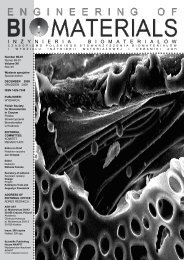69-72 - Polskie Stowarzyszenie BiomateriaÅów
69-72 - Polskie Stowarzyszenie BiomateriaÅów
69-72 - Polskie Stowarzyszenie BiomateriaÅów
You also want an ePaper? Increase the reach of your titles
YUMPU automatically turns print PDFs into web optimized ePapers that Google loves.
13<br />
RYS.1. Wwidma absorpcyjne warstw hydroksyapatytu osadzonych przy różnych temperaturach podłoża:<br />
a) 150 O C, b) 350 O C, c) 450 O C, d) 650 O C.<br />
FIG.1. Fourier spectra of deposited hydroxyapatite layers for different substrate temperatures: a) 150 O C, b)<br />
350 O C, c) 450 O C, d) 650 O C.<br />
Wyniki eksperymentu<br />
Rys.1 przedstawia widma absorpcyjne warstw hydroksyapatytu<br />
osadzonych przy różnych temperaturach podłoża.<br />
W widmie warstwy HA osadzonej w temperaturze 150 O C<br />
widoczny jest pik w okolicy 610cm -1 reprezentujący drganie<br />
zginające ν 4 grupy PO 4 . Pik ten poszerzony jest od strony<br />
mniejszych energii. Pik przy 480cm -1 odpowiada drganiom<br />
ν 2 zginającym grupy PO 4 . Pojawia się on przy temperaturze<br />
350 O C i jest obecny w widmie warstwy osadzonej<br />
w 450 O C. Poszerzenie piku przy 610cm -1 obserwowane<br />
w widmie warstwy osadzonej w 350 O C wskazuje na częściową<br />
zmianę struktury fazowej warstwy. Pojawienie się piku<br />
przy 480cm -1 sugeruje zmiany struktury fazowej osadzonego<br />
HA wraz ze zwiększaniem temperatury podłoża. Ponieważ<br />
przy temperaturach niższych niż około 400 O C osadzane<br />
warstwy mają strukturę amorficzną [1] przejście fazowe<br />
w temperaturze powyżej 350 O C dotyczy zwiększenia stopnia<br />
krystaliczności otrzymanych warstw. Można więc przyjąć, że<br />
zakres temperatur 350–450 O C jest najlepszy dla wzrastania<br />
warstw polikrystalicznych hydroksyapatytu.<br />
Rysunek 2 przedstawia dwu i trójwymiarowe obrazy<br />
topografii obszaru 1x1µm wraz z mapami fazowymi warstw<br />
hydroksyapatytu osadzonego w różnych temperaturach<br />
podłoża. Warstwa hydroksyapatytu osadzona w temperaturze<br />
150 O C ukazuje strukturę wyraźnie różniącą się od<br />
struktury warstwy osadzonej w temperaturze pokojowej [3].<br />
Powierzchnia tej warstwy wykazuje obecność konglometatów<br />
o rozmiarze 2–3µm, które składają się z krystalitów<br />
o wielkości 100nm. Krystality te charakteryzują się jednorodnym<br />
rozmieszczeniem na powierzchni warstwy. Mapa fazowa<br />
wskazuje, że osadzona warstwa zdominowana jest przez<br />
jedną fazę, może być to OCP - Ca 8 (HPO 4 ) 2 (PO 4 ) 4 •5H 2 O.<br />
Obecność pasm grupy CO 3 w widmie FTIR (1400cm -1 ,<br />
1470cm -1 ) wskazuje, że drugą fazą jest biologiczny apatyt<br />
- Ca 8 . 3 (PO 4 ) 4.3 (CO 3 -HPO 4 ) 1.7 (OH) 0.3 .<br />
Results<br />
Fig.1 depicts FTIR absorption spectra of HA coatings<br />
deposited at different substrate temperatures. In the spectra<br />
of HA coating deposited at 150 O C the peak at wave number<br />
value of 610cm -1 representing ν 4 bending mode of PO 4 group<br />
is visible. This peak is broadened toward lower energy. The<br />
peak at 480cm -1 corresponding to ν 2 bending mode of PO 4<br />
group appears at substrate temperature of 350 O C and is still<br />
present in spectrum obtained for temperature of 450 O C. The<br />
broadening of peak at 610cm -1 observed in 350 O C probably<br />
indicates partial changing of spatial distribution of stresses<br />
in deposited layers which can be influenced by changes<br />
of phase structure of layers. Emerging of peak at 480cm -1<br />
indicates changes of phase structures of deposited HA when<br />
the substrate temperature increases. Because at lower than<br />
400 O C temperature the deposited layer is characterized<br />
by amorphous structure [1] the observed phase change at<br />
350 O C refer to increasing of polycrystalline structure of layer.<br />
One can conclude that the range of substrate temperature<br />
between 350 O C and 450 O C is most appropriate for growth<br />
of polycrystalline hydroxyapatite coatings.<br />
FIGURE 2 presents two and three dimensional topography<br />
of 1x1µm area of HA layers deposited at different<br />
substrate temperatures together with corresponding phase<br />
maps. The hydroxyapatite coating obtained at 150 O C shows<br />
structure which is clearly different from structure characteristic<br />
for layers deposited at room temperature [3]. This coating<br />
consists of conglomerates of the size about 2–3µm which<br />
are built of crystallites which size is of the order of 100nm.<br />
This crystallites are characterized by homogeneous arrangement<br />
on the surface. Phase map indicates that in this case<br />
deposited layer is dominated by only one phosphate phase<br />
(OCP -Ca 8 (HPO 4 ) 2 (PO 4 ) 4 •5H 2 O. The FTIR spectrum of this<br />
coating indicates that the second phase present in this layer<br />
is biological apatite Ca 8 . 3 (PO 4 ) 4.3 (CO 3 -HPO 4 ) 1.7 (OH) 0.3 .













